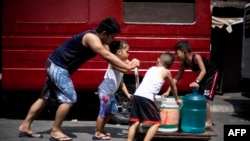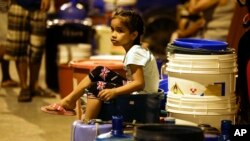A water shortage affecting some 6 million people in the normally rainy Philippines reveals management issue and threatens the the economy if dry conditions persist.
A House of Representatives committee on development in the country's major city Metro Manila was set to hold a hearing Monday on the water shortage. Tap water disruptions this month have caused periodic water outages in parts of the sprawling city and adjacent Rizal province.
The presidential office has vowed to investigate, too, an office spokesperson was quoted saying on Friday via the official Philippine News Agency.
The probes come as Filipinos demand to know why zones served by one water supplier face interruptions while those under another supplier are getting normal flows. The problem could eventually erode business sentiment and the otherwise solid reputation of President Rodrigo Duterte in a mid-term election year, analysts believe.
“It is now confusing, because it’s got so many narratives being spun,” said Antonio Contreras, political scientist at De La Salle University in the Philippines. “Initially, it was because there was a shortage of rainfall. It is now being painted as a problem of management.”
Dry weather, low reservoir level
The cyclical world weather pattern El Nino, which raises ocean temperatures, has brought lower than average rainfall to the Philippines since February, the country’s weather agency says. El Nino has caused parts of nearby Indonesia to run drier this year to date, as well.
Today people around Metro Manila are told their water will stop for several hours at scheduled intervals, prompting families to stock up in advance or buy water outside. In parts of the country hundreds of kilometers away from Manila, farmers are struggling to raise crops on parched land.
The La Mesa reservoir just outside Manila reached a critically low level of 68.9 meters, down from an ideal 80 meters, on March 10. The supplier Manila Water has apologized to users and urged them to conserve as it disrupts flows.
Another reservoir that supplies Manila is staying above crisis levels, and the company that operates it is not disrupting water delivery.
Political, economic fallout
Some Filipinos wonder whether a government agency is fabricating a “crisis” so it can use emergency relief funds, Contreras said. Others suspect the president will leverage the water problem before mid-term elections in May by solving it and looking like a "hero," he said.
El Nino could eventually “push rates higher” for water, said Jonathan Ravelas, chief market strategist with Banco de Oro UniBank in Metro Manila. Commodities might cost more along with daily water use, he said. Still, he added, the shortage has not reached nationwide.
“Basically, it’s a disruption until such time you get a replenishment of the dam and other sources where they can get water,” Ravelas said. “I think we will probably see more of the effects in the coming months. If El Nino will be severe, then that could affect some agricultural products.”
A hit to agriculture could raise consumer prices and affect domestic spending, said Rahul Bajoria, senior Asia Pacific economist with Barclays in Singapore. Inflation became an issue in mid-2018 as prices of basic necessities rose.
Getting water back
A Manila Water official told the congressional hearing Monday that a “widespread water interruption plan” that took effect Thursday had allowed reservoirs to refill and pumping stations to stabilize.
“The results I have seen on the ground beginning March 15 and through this most recent weekend have been encouraging,” the official said, as quoted by the company website.
The Philippine government advocates construction of a new dam, called Kaliwa, with funding from China, as another water source, domestic media reports say. But the project has raised fears about environmental degradation.
Separately, the international charity Water.org says by the end of 2019 it plans to help more than three million people get safe water and better sanitation.
“Having a more robust climate change policy is something that would possibly impact long-term investment implications, but I think the near-term focus is pretty much on rehabilitation and making sure disruption is as limited as possible and water supply is adequate for normal day-to-day operations,” Bajoria said.








